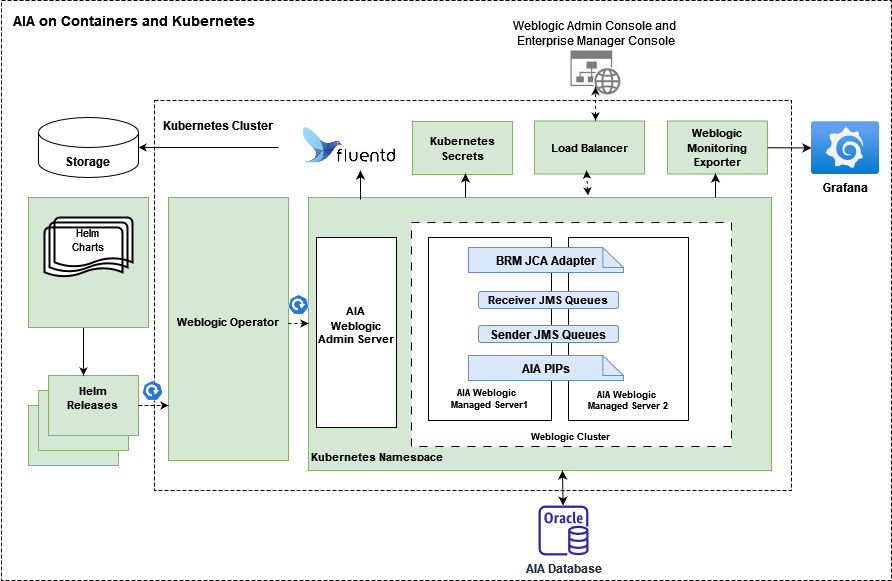1 Overview of the AIA Cloud Native Deployment
This chapter provides an overview of Oracle Communications Application Integration Architecture (AIA) deployed in a cloud native environment using container images and a Kubernetes cluster.
About AIA and the AIA Cloud Native Deployment
AIA for Communications is an Oracle Communications Solutions Integration framework that includes pre-built integrations using standard integration patterns, business processes, orchestration logic, and common objectives and services that enable seamless interaction with Oracle Applications.
The packaged integrations provide business and functional flows that map to key business processes in the domain of operations support system and business support systems for a communication service provider.
- Order to Cash for Siebel CRM Cloud Native
- Order to Cash for Oracle Communication Order and Service Management
- Order to Cash for Oracle Communications Billing and Revenue Management
Overview of AIA for Communications Cloud Native Deployment
AIA in a cloud native architecture increases operational efficiency by improving hardware utilization and scaling real-time business events to capture revenue.
The AIA cloud native deployment option combines the features and extensibility of AIA with the agility and efficiency of cloud infrastructure with DevOps aligned.
- Container images (Docker, CRI-O), orchestrated in Kubernetes - production support for AIA-RODOD Deployment on Kubernetes
- Install and manage using Helm charts
- Docker files and scripts for development and testing
- Lifecycle management using WebLogic Kubernetes Operator
- Siebel CRM Cloud Native 23.03
- Oracle Communications Order and Service Management (OSM) Cloud Native 7.4.1 Patch 10
- Oracle Communications Billing and Revenue Management (BRM) Cloud Native 12 Patch Set 8
See AIA Compatibility Matrix for information about the recommended and supported versions of applications.
AIA Cloud Native Architecture
The following diagram illustrates AIA on containers and Kubernetes.
Figure 1-1 AIA on Containers and Kubernetes
About the AIA Cloud Native Toolkit
The AIA cloud native toolkit is an archive file that contains the default configuration files, scripts for generating an AIA image and for deploying AIA in a cloud native environment.
The toolkit contains the following artifacts:
- Helm charts and configuration override values yaml files for configuring and managing AIA Order-to-Cash PIP deployment and SOA.
- Scripts for creating and managing secrets for AIA's edge systems, XRef, SOA and RCU.
- Scripts for generating AIA images.
- Scripts for restarting managed servers.
- Scripts for deploying AIA in a cloud native environment.
- Scripts for managing the life cycle of an AIA cloud native instance.
Table 1-1 AIA Cloud Native Toolkit Artifacts
| Artifact | Artifact Type | Description |
|---|---|---|
| AIA Docker Image | Build | This is the AIA image that you build using the scripts and the
Dockerfile provided with the toolkit.
Note: Dockerfile is the docker image configuration file to be passed into the docker build command. |
| SOA Cloud Native Docker Image | Build | This is the SOA cloud native CPU image that is later than January 2023 that you pull before building the AIA image. |
| Secrets | Deployment | These are Kubernetes secrets used to create credentials and SSL certificates for systems. |
| Helm charts | Deployment | These are the charts used for other configuration parameters and sizing. The domain is static, as recommended by SOA. Hence, the maximum number of servers cannot be changed after the deployment, but they can be shut down and brought up. |
| Build scripts | Build | These are scripts used at build-time. |
| Deployment scripts | Deployment | These are scripts used to deploy the AIA artifacts, custom artifacts, and other artifacts. |
| PV/PVC | Deployment | This is the domain on Persistent Volume (PV) model (as recommended
by SOA) that AIA cloud native uses.
A persistent volume (PV) is a piece of storage in the Kubernetes cluster, while a persistent volume claim (PVC) is a request for storage. |
| Config Map | Deployment | This contains the deployable custom artifacts such as custom composites. The deployment job pods are configured to use these artifacts. |
| Scripts | Deployment | These are the scripts for restarting the managed servers (WebLogic Operator deployed) in the cloud native environment. You update and run the python script, which invokes WKO-based shell scripts to restart the servers. |
About Helm Charts and Overrides
- For managing Kubernetes
- For defining, updating, deploying, and managing versions
- For managing release history
- For customizing values and templates
- aia-comms-pv-pvc: This chart creates AIA PV/PVCs and service accounts.
- aia-comms-deploy-aiapip: This chart deploys AIA Foundation Pack and AIA Pre-integrated Packs (PIPs) in SOA and WebLogic servers.
- aia-comms-certs: This chart manages SSL trust certificates of Siebel and OSM in SOA and WebLogic servers.
The charts pick the customized values defined in the custom values.yaml configuration file and map them to the respective Kubernetes yaml files defined in the chart`s /template directory. Each chart can be installed and managed through helm commands.
For details about sizing, see "Oracle SOA cluster sizing recommendations".
About Helm Overrides
The specification files are consumed in a hierarchical fashion. If a value is found in multiple specification files (layers), the one further up the hierarchy takes precedence. This allows the instance specification to have the final control over its configuration by being able to override a value that is prescribed in either the shape or project specifications. This also allows Oracle to define sealed, base configuration, while still providing you the control over the values used for any specific AIA instance.
The main chart is aia-comms-chart within which there are multiple sub charts. The values in the values.yaml file are global and accessible to the sub charts.
The instance specification remains the final authority on any values that are found in multiple specification files.
